Yesterday. at Mike Splane’s latest chess party, Uyanga Byambaa showed an endgame that could have come straight out of The Walking Dead. But actually the whole game was very interesting, not just the endgame. She told us, “This is the toughest game I’ve had to move on from. I really didn’t understand why I lost.” Well, Uyanga, that’s what we we’re here to help you with!
Uyanga has been on a bit of a roll lately. She finished second in the under-2200 section at the Golden State Open in January, with an impressive score of 6-1, and her only loss coming to the winner of the section, Siddharth Banik (who scored 6½-½). The third-place finisher was a full point behind Uyanga at 5-2.
However, Uyanga didn’t bring any of her games from the Golden State because she wanted to show us her painful defeat last week at the Mechanics Insitute, in the ongoing Tuesday Night Marathon. She was paired against IM Elliott Winslow, with a chance to move into first place if she won.
Uyanga Byambaa — Elliott Winslow
1. e4 c5 2. Nf3 d6 3. d4 cd 4. Nxd4 Nf6 5. Nc3 a6 6. Bc4 e6 7. Bb3 b5 8. Bg5 Be7 9. Qf3 Qd7?!
FEN: rnb1k2r/3qbppp/p2ppn2/1p4B1/3NP3/1BN2Q2/PPP2PPP/R3K2R w KQkq – 0 10
This is the first surprise. According to Gjon Feinstein, who knows him well, Winslow is very knowledgeable about the Najdorf. But this move looks a bit odd. Either 9. … Qb6 or 9. … Qc7 are more commonly played. In 2008 Topalov [Correction: Ivanchuk (see comments)] had a fantastic win with White against Karjakin in the latter line, where Topalov [Ivanchuk] sacrificed his queen for two pawns (!!) on e6. Could that be what Winslow was afraid of?
Be that as it may, 9. … Qb6 looks more natural, and on d7 the queen turns out to be badly placed, as we shall see.
10. O-O-O Bb7 11. Qh3 b4?
FEN: rn2k2r/1b1qbppp/p2ppn2/6B1/1p1NP3/1BN4Q/PPP2PPP/2KR3R w kq – 0 12
In conjunction with 9. … Qd7 I think this move is just a mistake. Here I think Uyanga missed her first opportunity.
12. Bxf6 Bxf6 13. Na4? …
To me, the right way to play it was 13. Ba4 Nc6 14. Nd5! I don’t really know much about the Najdorf, but what I do know is that you should play Nd5 any time it is even close to sound. Here it’s completely sound. If 14. … ed (or 14. … Bxd4 15. Rxd4 ed) 15. Qxd7+ Kxd7 16. ed White will win back the piece on c6 and should end up a full pawn ahead.
13. … Bxd4 14. Rxd4 Nc6 15. Rd2 Qc7 16. Qg3 O-O-O 17. R1d1 Ne5? 18. f4 Nc6
FEN: 2kr3r/1bq2ppp/p1npp3/8/Np2PP2/1B4Q1/PPPR2PP/2KR4 w – – 0 19
Black realizes that his intended 18. … Nc4? would run into a fork after 19. Bxc4 Qxc4 20. Nb6+, and so he has to beat a humiliating retreat back to c6. Basically he has awarded Uyanga two free tempi. So far one has to say that Winslow is not in good form, playing moves in the wrong order and missing little tactics. But now the question is what Uyanga should do to take advantage of Black’s inaccuracies. Or as she said it, “Should I rip?” (In other words, should I take on g7?)
One of the things I like about this game is that there are lots of moments like this, where she had to choose between two moves that are both good, but the question is which one is better.
19. Qe3? …
I think that she should capture at g7. This is a kind of mistake that I make pretty often, too. I get so caught up in strategic, non-materialistic play that I forget that winning a pawn is sometimes good strategy, too. Good players win by sacrificing their opponent’s pieces.
A key point here is that 19. Qxg7 isn’t just winning a pawn; it also serves a positional purpose. It creates a nice hole on f6 that White can sink his queen on, putting permanent pressure on e6 and f7 and also keeping an eye on the h8 rook (which keeps the other rook tied down to the back rank).
Uyanga said that she chose 19. Qe3 because she wanted to improve the position of her knight on a4, which isn’t doing anything. This is a perfectly valid point, and it’s often a useful way of coming up with candidate moves: What is my worst piece, and how can I make it better? But the trouble is that the knight on b6 is actually less secure than it was on a4, as we’re going to see.
19. … Kb8 20. Nb6 …
Looks nice, but looks can be deceiving.
20. … Na5!
FEN: 1k1r3r/1bq2ppp/pN1pp3/n7/1p2PP2/1B2Q3/PPPR2PP/2KR4 w – – 0 21
21. Kb1? …
Uyanga misses the threat. Her queen is overloaded, having to defend both the pawn on e4 and the knight on b6. Probably she has to play 21. e5, but then I think Black has easy equality, for example 21. … de 22. Rxd8+ Rxd8 23. Rxd8+ Qxd8 24. Qxe5+ Qc7! and the knight is taboo because after 25. Qxa5? Qxf4+ Black may even be winning.
21. … Bxe4! 22. Nd7+ Rxd7 23. Qxe4 Nc6
and Black is a solid pawn up. However, the time situation is relevant here: Winslow has only 5 minutes to get to the first time control (he has to make 7 moves in 5 minutes). In the time scramble he blundered a pawn and Uyanga was back in control again. I’m now going to skip ahead a few moves to the following interesting position.
FEN: k1r5/4r1pp/p2R1p2/4np2/BQq5/8/PPP1R1PP/1K6 w – – 0 34
This should be a pretty easy tactical puzzle, but it’s a pretty one nevertheless. I would say “White to play and win” except that White played the correct move and still didn’t win!
Have you got it?
Uyanga played 34. Bc6+!, an interference sacrifice that cuts the communication between Black’s queen and rook and threatens 35. Qxc4. If 34. … Rxc6 then 35. Rd8+ is instantly winning. So Black is forced to give up his queen.
34. … Qxc6 35. Rxc6 Nxc6
And here Uyanga made a very instructive mistake. Just as she did on move 19, she plays too non-materialistically. And her mistake again was to follow what is normally good advice. The rule is to not make things hard for yourself. If you see that you can get to a theoretically won endgame, do so, even if it means giving up a little material.
So Uyanga gave back her queen for a rook and a knight to get into a “theoretically won” rook and pawn endgame. But before we look at that endgame, let’s see what would have happened if she had been a little bit more materialistic and played 36. Qb6! First of all, it’s hopeless for Black to defend the a-pawn with 36. … Ra7 because 37. Re8! is curtains. This is already enough to make me want to play 36. Qb6.
So Black has to give up the a-pawn with 36. … Rxe2 37. Qxa6+ Kb8 38. Qxe2 (diagram)
FEN: 1kr5/6pp/2n2p2/5p2/8/8/PPP1Q1PP/1K6 b – – 0 38
What do you think about this endgame?
I think that a lot of people tend to avoid positions with an unusual material balance (here, queen against rook and knight). Uyanga preferred the more familiar territory of a rook endgame. But in fact, it should be very apparent that White’s advantage is OVERWHELMING.
To evaluate queen versus multiple-piece positions, here is a checklist of two questions you should ask, plus a third question if it’s an endgame:
- Is the defending king exposed?
- Are there loose pawns?
- Does the defender have any chance of setting up a fortress?
If the answer to (1) and/or (2) is yes, it’s good for the queen. And if the answer to (3) is no, it’s good for the queen.
Here all of the signs are great for the queen. Black’s king is utterly exposed, so the queen will be able to check and set up forks to her heart’s content. There are lots of buttons on the kingside ripe for the plucking (g7 and f5 particularly). And of course there is no hope for Black to set up a fortress, because White has three monster pawns on the queenside that will smash through any obstacles.
There’s no question in my mind that Uyanga should have gone for this. There is no subtlety involved. She can just play caveman chess and win.
Instead, let’s look at the endgame that arose after the move Uyanga chose, 36. Qxe7?! Nxe7 37. Rxe7 Rg8!
FEN: k5r1/4R1pp/p4p2/5p2/8/8/PPP3PP/1K6 w – – 0 38
Here Uyanga played 38. c4, a move that I think is perfectly fine. Some of the people at the party kept on analyzing the endgame after we finished and took a break for speed chess. I was too busy playing speed chess to follow all of their analysis, but I think they reached the conclusion that 38. Kc1 would have been even better, to get the king over to the kingside faster. Be that as it may, I think White is still winning after 38. c4; Uyanga’s mistake came later.
However, the key thing to discuss in this position is why the position already contains the seeds of White’s destruction. (And therefore why it was so important for White NOT to choose this endgame but choose the queen endgame instead.)
Uyanga said that when she got to this position, she thought White must have a huge advantage, because her rook is in the best possible place, the seventh rank, while Black’s rook is buried on g8, seemingly doing nothing.
But the position is very deceptive. First, let me make a philosophical point: Rooks are great attackers but they are really lousy defenders. That is what makes rook-and-pawn endgames so sharp. A rook is only good at defending against passed pawns if it can get behind them. In this case, one reason the position is so perilous for White is that if Black can set up a formation with his pawn on g5 and his rook on g6, White won’t be able to get behind the f-pawn (because the f6 pawn blocks the rook) and she won’t be able to get behind the g-pawn (because Black’s rook has the g-file).
Second, Black’s seemingly “defensive” rook on g8 is actually in exactly the place he wants to be — behind his future passed pawns. There’s also a good chance that Black will be able to open up the g-file with a pawn trade, and then Black’s rook can go to g2 and be just as active as White’s rook. So Uyanga misjudged the relative strength of the rooks. White’s rook is pretty but doesn’t do much, especially on the defensive end. Black’s rook looks humble at the moment but has great potential to move up in the world.
And then there are the kings. Again, it superficially seems to be all in White’s favor. Black’s king is imprisoned on the back rank. White’s king will be able to roam all over the board. But again, looks can be deceiving. Because White’s rook will soon be cut off from the defense, it is completely up to White’s king to defend the kingside pawns, and he is a lo-o-o-ong way away. Meanwhile, Black’s king has only one function in life, and that is to defend against White’s queenside pawns. For that task, he is in just the right place.
Yes, Uyanga should still win, but this discussion shows that her advantage is by no means as clear-cut as it appears. All three results (win, loss, draw) are still possible. It also means that job number one for her is to get her king over to the kingside. Pushing her own pawns is a lower priority. She cannot win a pawn race.
The game continued 38. … h5 39. Kc2 f4 40. b4? This is where I think Uyanga went seriously wrong. If she plays 40. Kd3, she still has time to get her king over to defend, and the tactical trick that Winslow had in the game would not have worked.
Winslow by this time was down to under a minute on the clock, but fortunately his job is very easy. All he has to do is push his pawns.
40. … h4! 41. h3 …
White could not ignore the threat of … h3.
41. … g5 42. Rf7 …
Too little, too late. Black doesn’t even have to defend the pawn.
42. … g4! 43. Rxf6 …
FEN: k5r1/8/p4R2/8/1PP2ppp/7P/P1K3P1/8 b – – 0 43
Now see if you can find Black’s winning move.
(Space inserted so you can think about it.)
Winslow played 43. … f3!! and amazingly, there is nothing White’s rook can do to stop the pawns. This is the part of the game that reminds me of a zombie movie. Black’s pawns are the walking dead: you can whack off one, you can whack off another, but there’s always more of them and they just keep on coming.
I didn’t write down the rest of the moves, but I think the game ended something like this: 44. gf g3! (Now what do you think about that “passive” rook on g8?!) 45. Rxa6+ Kb7 46. Re6 g2 47. Re1 g1Q 48. Rxg1 Rxg1 49. Kd2 Rg3 50. Ke2 Rxh3 51. Kf2 Rg3 and White resigned, because she has no way to stop the last of the zombies.
You can see why Uyanga was so heartbroken. But Winslow should get some credit. He hung in there for a very long time in an unpleasant position, and when he finally got his chance for a swindle, he didn’t miss it.
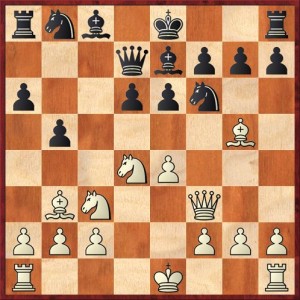
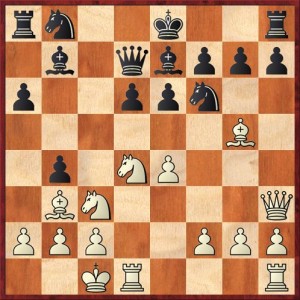
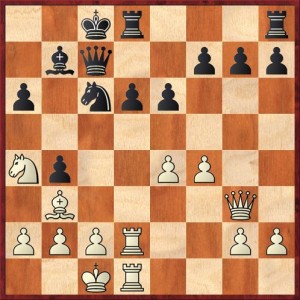
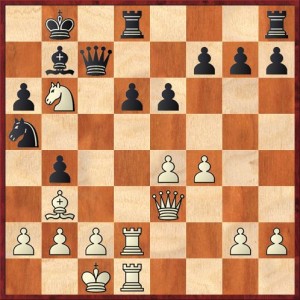
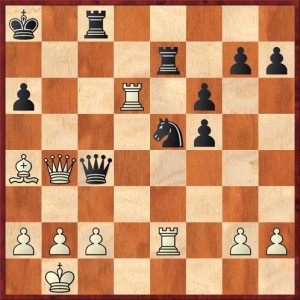
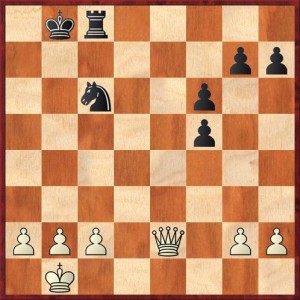
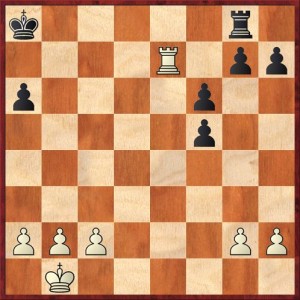
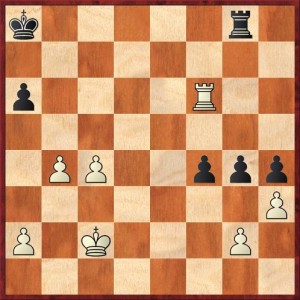



{ 5 comments… read them below or add one }
This is probably tangential, but it takes a psychological shift to transition to an endgame (albeit, with advantage) from an slippery (my analogy is that the middlegame was a stiff quantity), complicated middlegame. It’s something that I often fall for, although I do feel more happy playing an endgame than other phases – but the transition has to be smooth or else it’s easy to blow it. I think here’s where we should take a walk or something. But unfortunately, when we reach an endgame, it often happens that we’re running low on time.
So in the end it’s a zero sum game. What you gain in the middlegame, you lose in the endgame.
The post implies that Uyanga saw 36. Qb6, but perhaps she did not.
We might all remember that even Gelfand failed to beat Anand in a “theoretically won” R ending in their match.
Wow! An awesome article! Thank you Dana for your incredible analyzes. I learned even more reading your analyzes. Most heartbreaking was the queen endgame I was almost going to play, computer gives +4 pawn advandage. Of course, Knowing that, it depressed me even more.
(1) I know a bit about 9…Qc7 (9…Qb6 no longer as popular) but didn’t think I knew enough. The line 10.e5 Bb7 11.exd6 Bxd6 12.Qe3 Bc5 (12…Nc6!?; 12…Be5!?) 13.0-0-0 Nc6 14.Qxe6+!!? was Ivanchuk, not Topalov, vs. Karjakin, Amber (rapid) 2008. I’ve been through analysis showing that Black is okay, but haven’t digested it. Plus I don’t know all the other ways White can and has played. So I wanted to side-step; but I confused 9…Qd7 here with the position after 8.0-0 Be7 9.Qf3; here 9…Ra7!? is a secondary try, given high marks by Ftacnik. Oh well.
(2) I overlooked how good 12.Ba4 Bc6 13.Nxc6 bxc3 14.Nxe7 Qxa4 15.Nc8(!). But with the exchange on f6 thrown in, 13.Ba4 Bc6 13.Nxc6 bxc3 might cut it.
(3) How could I have overlooked the “little tactic” on 18…Nc4 indeed! Occam slits his own throat again: on this particular note you might want to recalibrate your assumptions about IMs or 2300 players, or whatever I am. I was just trying not to lose my d6 pawn, and lost faith in 18…Ng6 — although they both lead to the same dodgy position after 19.f5 exf5 20.exf5 Ne5 21.Rd4 a5.
I suspect “Comments” won’t take even this much; more later…
Thanks for the comment, Elliott! It’s always interesting to hear from *both* players what was going through their minds, and of course IMs/2300s are allowed to slip up … It was a great game, and as I said, I admired your persistence and resourcefulness in the endgame. One mark of a master is winning even when things don’t go well.
(1) Thanks for the correction on Ivanchuk.
(2) I was wondering whether there was any difference between 12. Ba4 and 13. Ba4. At the party we didn’t really look at … Bc6, so we missed the Nxe7-c8 trick. Looks as if 12. Ba4 is the correct move order, then.